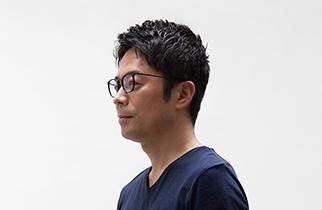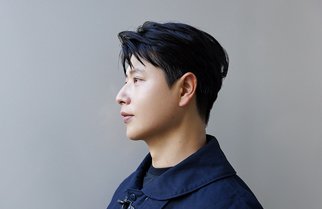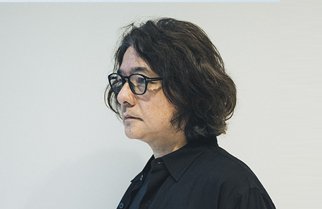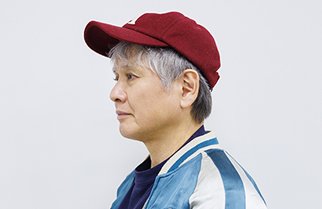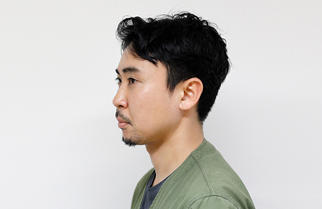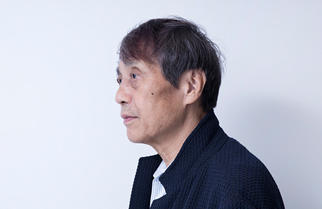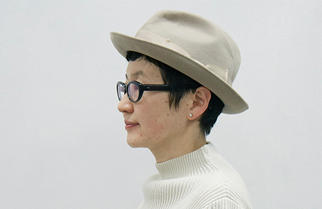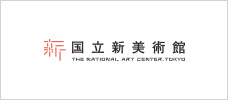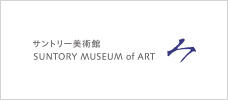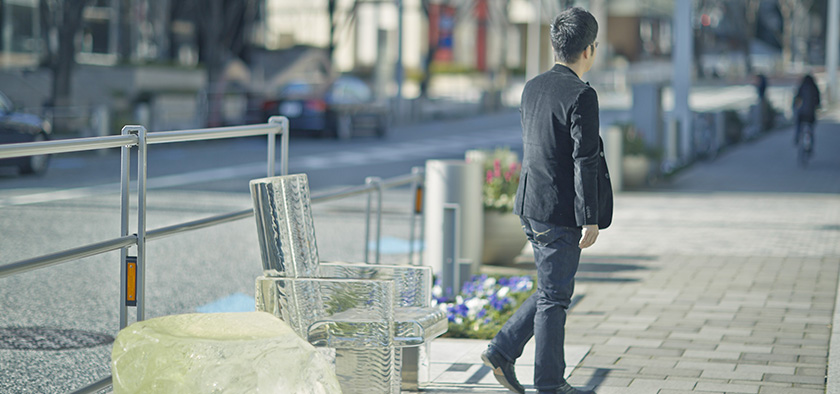
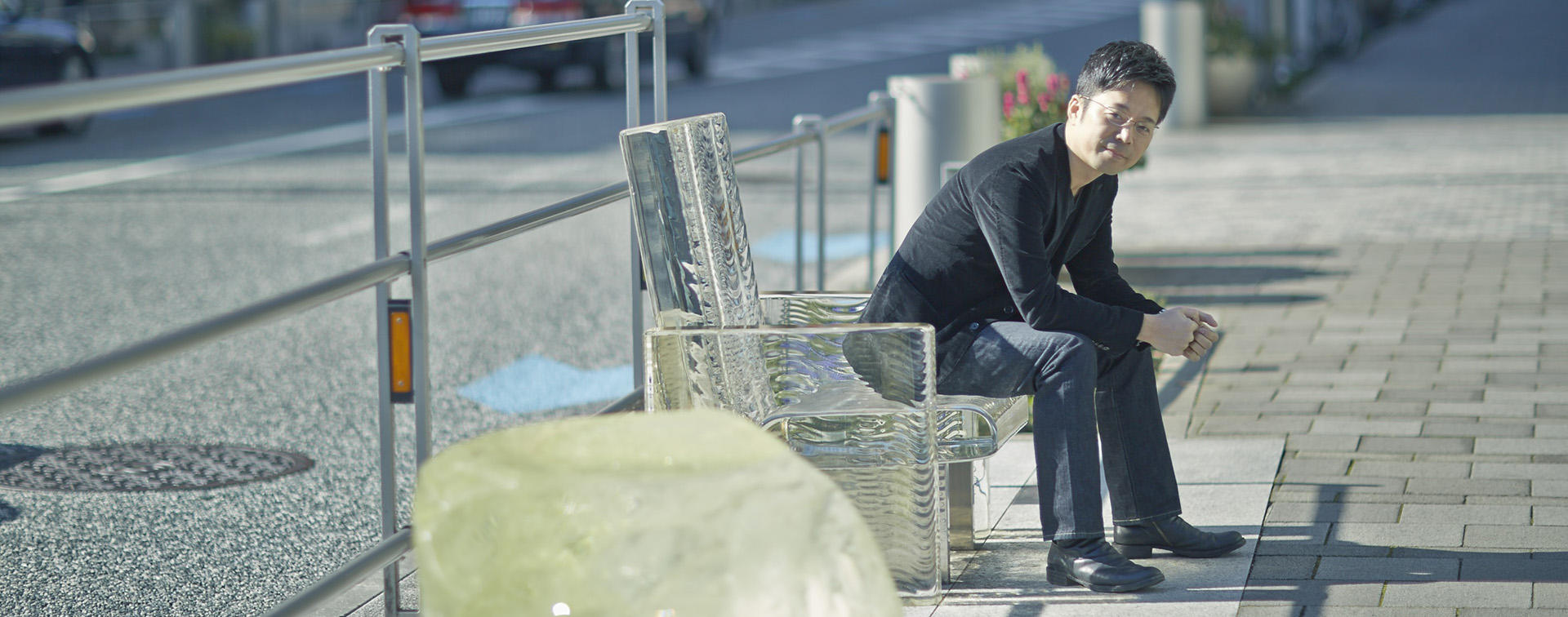
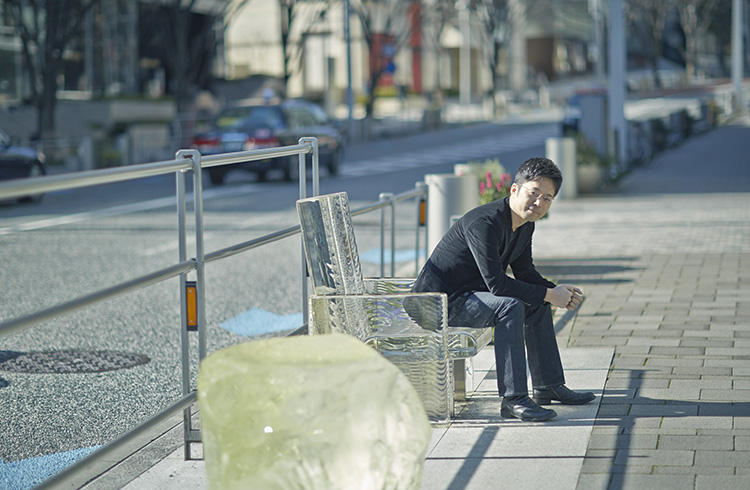
Looking for the creations of the future
Always asking “Why?” and expressing the unexplainable
In Roppongi's Keyakizaka-dori is the "Chair that disappears in the rain" created by Tokujin Yoshioka, a designer who is active worldwide. His works have been displayed at the "Second Nature" exhibition at 21_21 DESIGN SIGHT and the "Sensing Nature" exhibition at Mori Art Museum. Yoshioka's involvement with Roppongi began more than 10 years ago; he said he has always hoped this area would become "a place closest to the future." We asked him about his views on Roppongi and on creations of the future.
A project to mark a new beginning
The first large project in Roppongi I was engaged in was the Roppongi Think Zone which was set up in 2001 as a promotion project for Roppongi Hills; I was in charge of designing the building and the interior. In the 1990s, after the Berlin Wall was broken down in Germany, and redevelopment began at the center of the city, many corporations and architects set up places that were like information centers. The Roppongi Think Zone was aimed at doing something hopefully bigger than that - it was a project to create a place for public presentation in Roppongi.
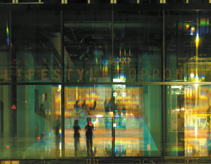
ROPPONGI THINK ZONE
An open art space (now closed) which was set up in 2001 on Roppongi-dori as a promotion project for Roppongi Hills which was then under construction. Numerous innovative art events were held using music and images projected on a gigantic 14 x 18 meter-screen placed on the floor.
Photo: Jun Kumagai
I myself had just become independent in 2000 and had set up my own office, and the project marked the start of a new beginning for me. It was my first time to design a whole building. I was also given many other opportunities such as designing the street furniture "Chair that disappears in the rain" on Keyakizaka-dori.
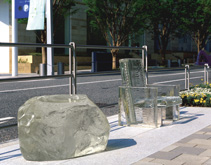
Chair that disappears in the rain
A work that was installed in 2003 for the Roppongi Hills streetscape project. Like a piece of glass whose outline fades when placed in water, the chair seems to disappear on a rainy day.
photo:Mori Building
The street furniture project took a very long time to complete because we needed to get permission to install them in public places. It is rare that glass is chosen to make objects that many people will touch, but I thought glass was suitable because it lasts almost forever and doesn't decay. I thought of making an object that could be easily remembered; I wanted people to use it when waiting for each other so they could say, "I'll be standing near that glass chair." When I go to Roppongi, I still greet the "Chair that disappears in the rain". I say "How are you?" (laughs)
Roppongi, a place closest to the future
In the beginning, I did not imagine at all that within only 10 or so years, Roppongi would change so much. But I do remember listening to the people at Mori Building who were developing Roppongi Hills; I listened to their future vision of Roppongi and I vaguely thought, "It would be nice if this place could become a place closest to the future."
By 'future', I don't mean the technological future. I was thinking of a comfortable place for people where one could also get a sense of the future. People work, have meals, and spend their lives here, so it's important to consider people's lifestyles.
What was initially most surprising to me was the plan to open an art museum at the top of a building. There were questions about taking up the artworks to such a height, and about the flow of visitors. These matters were discussed, but the museum turned out to be a success, drawing a lot of people. I don't think there is any other museum in the world that is so high in the air.
The art museum helped make Roppongi a cultural place; when Tokyo Midtown was later completed, there was a synergetic effect, and the area has been clearly invigorated. Now, in addition to design and art, Roppongi has much to offer, including cuisine, and it has become an interesting area, providing everything for all kinds of lifestyles.
Towns that offer unique experiences
As development in a town proceeds, there is a tendency for the same kind of streets and buildings to be built. When a new place is developed, people flock to it. Then a while later, they all go to another new place - that phenomenon is repeated. To differentiate itself, a town needs to offer a unique experience that cannot be had elsewhere.
The success of Mori Art Museum is an example of that. There is also the 21_21 DESIGN SIGHT in Tokyo Midtown, and all kinds of events are held such as the Design Touch in the autumn. Roppongi has become an area of design and art; in other words, it has become a cultural area.
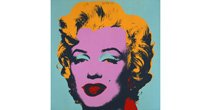
Mori Art Museum
An art museum on the highest floor - the 53th floor - of Roppongi Hills Mori Tower. Since opening in 2003, it has held many exhibitions mainly in contemporary art. To mark its 10th year, the "Andy Warhol- 15 Minutes Eternal" exhibition is currently being held. It will be on until May 6, 2014.
© 2014 The Andy Warhol Foundation for the Visual Arts, Inc. / Artists Rights Society (ARS), New York Marilyn Monroe™; Rights of Publicity and Persona Rights: The Estate of Marilyn Monroe, LLC marilynmonroe.com
In the past, towns in Japan were developed and transformed with the aim of becoming urban. But now people are not interested in towns unless they reflect the characteristics of each region. It's not just towns that need to be unique; countries and regions also need to reflect their own character. The places people find appealing and interesting are those which are distinctive, and clearly different.

The unexplainable appeal of culture
The culture of Roppongi seems to have been created over the years by the designers and architects like Issey Miyake-san, Shiro Kuramata-san, and Arata Isozaki-san who gathered here and exchanged opinions. Then the commercial facilities and art museums were built, and many people from abroad began to visit; I think Roppongi will evolve even further in the future as a place that emits culture. Miyake-san who is director of 21_21 DESIGN SIGHT is probably thinking that the next step to be taken in Roppongi is the creation of culture itself.
I often go to all kinds of concerts and art performances such as ballet. I really like the experience of being with a lot of other people and sharing the thrill. When I go to such places, I think to myself, "Culture is great." I don't know why I feel that way - I can't explain in words. I can't point to a reason, but culture is inspiring. There is something wonderful about culture that cannot be measured logically.
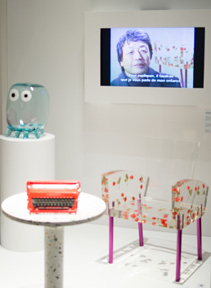
Shiro Kuramata
Internationally acclaimed interior designer (1934-1991) known for works such as the "Miss Blanche" chair made from transparent acrylic resin. Was awarded the Ordre des Arts et des Lettres (Order of Arts and Letters) by the French cultural ministry.
Arata Isozaki
One of Japan's foremost architects, leading the way in postmodernism architecture. Active both in Japan and abroad, his works include the Museum of Contemporary Art, Los Angeles and the Sports Complex Pavilion in Barcelona.
It would be nice if Roppongi had more places where people could appreciate culture on a more comprehensive scale, and not just in the genres of design and art.
The shift in interest from things to time
When working, I always think about the future and try to imagine what it would be like 10 years later or 100 years later. I feel that "time" is an important element when thinking about the future. That's because instead of getting satisfaction in owning things, people are becoming more interested in how they spend their time.
So rather than thinking about gaining happiness through things, we need to think about how we can plan and arrange for a happy time. The planning can affect people's perceptions and change the quality of time. More thought should be given to how people spend their time in towns and other places; I'm sure that would lead to new businesses.
In the past, magazines and television offered information on what were deemed to be the interesting things and the must-visit places, and everyone heeded what they said. But today, individual people send out information on what they felt was good or bad, and other people make decisions based on those views. The element of individuality is becoming stronger, and we're now living in times where the individual emits information and creates culture.
Creators should indicate the direction of the future
From a designer's perspective, it looks certain that things are going to be increasingly designed and made by individuals in the future. An individual can now make an advertisement, selecting the font and layout on a personal computer; that used to be a thing that only a designer could do.
We're no longer in an age where a limited number of people make presentations to society; everyone now has the opportunity to present their ideas, and there are fewer instances of remarkable talent going unnoticed. On the other hand, there does seem to be a minus side to this: when I look at the works of students these days, their ways of expression are similar and their thoughts seem to have become unified.
Everyone now has the opportunity to make works they want to make and they have the means to show them and let people know about them. In times such as these, I sometimes wonder about what the specific role of designers and artists should be. I often say to my designer friends, "I think the days are ending when only designers do design."
Anyone can design a simple-shaped thing. But a creator needs not only to create the shape, but to have new ideas and to be able to look ahead into the future. From now on, I think creators will be expected to indicate the direction of the future and the way of thinking for the future.
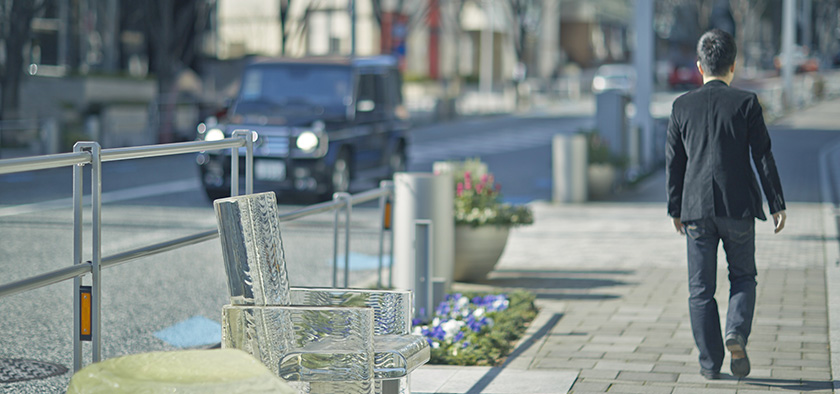
Design is not just about making different shapes
The word "art" currently refers to paintings and sculpture, but perhaps a hundred years from now, it might mean something totally different. Photography, for example, has a short history of being recognized as art. We don't even know whether designers will be existing or not in the future. Maybe other genres such as science will be using elements of design and art.
Actually, I myself am not certain about what is necessary to create our future. But one thing I can say for sure is that new designs will come from thinking about the origins of objects.
The other day, I had the opportunity to teach about designs to children. As an example, I talked about designing a cup and how we should start by thinking about the function of a cup. A cup is originally meant for drinking tea or water. When you think about the essential purpose of things, some people might say they want a round cup, while others might prefer a square cup - these different views lead to meaningful designs. Design is not just about making different shapes - it goes beyond that.
The passion to make ideas into reality
Designing things involves learning about yourself - you ask yourself what creating things means to you, and what your preferences are. When you design, there are murky matters that cannot be understood, but in the process of making your work, the outlines become clearer. For example, when I made the "Chair that disappears in the rain", the initial idea was to make a chair that had no shape. The important thing is the fundamental idea or basic approach - the actual shape of the work can come later.
What I like best are transparent things that give off auras, and I have a strong desire to make such works. The creation of things starts from having a passionate desire to make ideas into reality. I think things made with a headstrong passion are more appealing to people than things made after various problems and obstacles have been sorted out.
Brilliant works of art have an aura that changes the atmosphere around them. Ever since a student, I've been wondering about how to make such works, and I still haven't found the answer. But I've always created works while asking myself inwardly whether they resonate with me.
Always asking "Why?"
The basic purpose of design is to improve society and help people. I like making works that are completed by the involvement of people - the interaction between works and people is important to me, and I want to continue paying attention to that.
With a personal computer now, people can see whatever they want and make simulated visits without actually going anywhere. But when people really get the urge to go somewhere and see things with their own eyes, it's when they can only get the experience physically. The "Snow" installation at the "Sensing Nature" was very interesting in that sense, with people looking at it and exclaiming, "Oh!" It was the same with the "Crystallize" exhibition held recently at the Museum of Contemporary Art Tokyo. I hope to continue making works which personally intrigue me and which I feel compelled to complete.
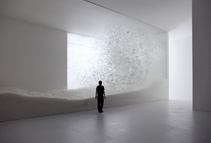
"Sensing Nature" exhibition
An exhibition themed on perceiving mother nature which showed the works of three artists: Tokujin Yoshikoka, Taro Shinoda and Takashi Kuribayashi. The photo is of the "Snow Installation" where a huge pile of feathers floated in a large space which was 14 meters wide and 6 meters high. The exhibition was held at the Mori Art Museum from July 24 to Nov. 7, 2010.
I always try to ask myself, "Why?" Why do I like this person? Why does this taste good? Why do I think this is nice? What is the sense of beauty that is common around the world - that makes everyone say something is marvelous? That final question does not have an answer, but it is the incomprehensible aspect which I find to be appealing and lovely.
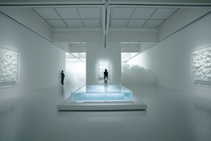
"Tokujin Yoshioka - Crystallize" exhibition
An exhibition held at the Museum of Contemporary Art Tokyo from Oct. 3 2013 to Jan.19 2014 showing around 30 of Tokujin Yoshioka's works - some for the first time in Japan. Among the works on display was "Swan Lake" - an installation whose crystals were formed by playing music to them. It was Yoshioka's largest solo exhibition to be held in Japan, and offered visitors a comprehensive view of the artist's works.
Editor's thoughts
Yoshioka-san thoughtfully talked to us about the wonderfulness of culture, the strength of artworks, and the sense of beauty that is common around the world. He repeatedly said that he cannot fully grasp the things that are appealing to him. Creators are no doubt people who keep pursuing the things that are elusive.(edit_kentaro inoue)




